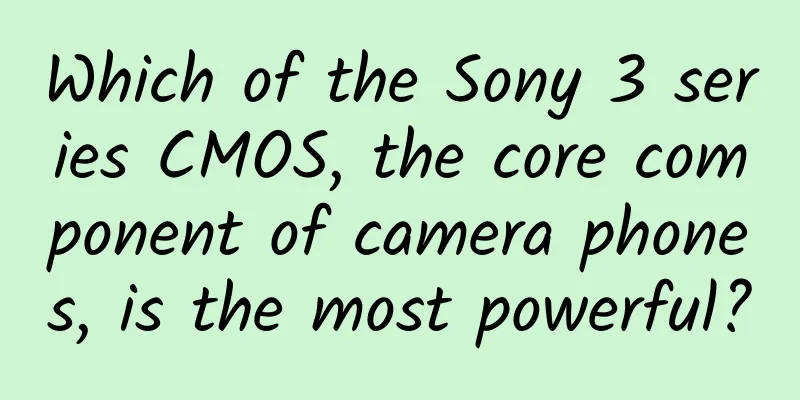Which of the Sony 3 series CMOS, the core component of camera phones, is the most powerful?

|
If we simply review the development of Sony IMX CMOS, we will find that: From 2013 to the first half of 2014, the Sony IMX series CMOS used in the mobile phone industry were mainly IMX135 and IMX179. The former was represented by LG G3, Samsung Note 3, etc., while the IMX179 was represented by Nexus 5 and Huawei P7 (front camera), etc. Since the summer of 2014, the 2nd series CMOS represented by IMX214 began to appear and became the mainstream in the market in 2015. The final product of Sony's 2-series Exmor RS CMOS - IMX286 In theory, the IMX298 (equipped in Huawei Mate 8, etc.) released in November 2015 marked the end of the era of Sony's 2-series CMOS . But in fact, the last 2-series CMOS released was the IMX286 used in Huawei P9 in April 2016. And starting with the IMX318 in February 2016, Sony's Exmor RS CMOS truly opened the era of the 3-series. So before starting the main text, I will first make a list of the relatively mainstream Sony IMX 3-series CMOS on the market, list their respective parameters, specifications, features and representative models, and then select some representative products to introduce. Sony 3 series Exmor RS CMOS parameter comparison. It took me almost an hour to come up with this table by checking various materials and FQ... Through such a table, there are several significant features that I would like to talk to you about: 1. The model number has nothing to do with the product level . Although in general, the model of IMX CMOS has a certain correlation with the product release time, it is not absolute. There are also models with large numbers that are released early and models with small numbers that are released late. In addition, the model number has nothing to do with the product positioning. It does not mean that the model with a large number must have a higher configuration than the model with a small number. This must be paid attention to. 2. Phase focus has become popular . It can be seen that among all the 10 CMOS models of the IMX 3 series, almost all of them have realized PDAF, which is phase focus. Some of them are not written in the table because there are more significant functional points, so you may have also found that since the second half of last year, the word PDAF has appeared less and less at mobile phone press conferences. Why? It is not because it is not supported, but because almost everyone supports it, it does not seem to be a mainstream selling point. Schematic diagram of RGBW architecture (Image source: gsmarena) 3. RGBW architecture disappeared . In the era of 2-series CMOS, IMX278 used in Huawei P8 and IMX298 used in Huawei Mate 8 are both RGBW architectures modified on the basis of Bayer array. The original intention of this architecture is to allow more external light to be incident on CMOS to increase the amount of light entering, but in actual shooting, it caused the color expression of green subjects to be significantly reduced. Therefore, this RGBW structure did not appear in IMX 3 series CMOS. It is not realistic to introduce all these 10 CMOS in detail. First, some CMOS are unpopular, and second, the workload is too large. So let's introduce some relatively popular products below. The first is Sony IMX318, which was released in February last year and first launched by ASUS in May. In my in-depth analysis of Sony IMX318 written in March last year, I predicted at the beginning that "the next Exmor RS star product has been born and is likely to sweep the flagship smartphone market in the second half of this year (2016)". Facts have proved that my judgment is basically accurate. Since Asus first launched this CMOS, Nubia mini S and Xiaomi Note 2 have also adopted this CMOS - although IMX318 is not a model that relies on high image quality to win the market. Phase + contrast composite autofocus is not unique and original to Sony. Previously, vivo and OPPO both used this technology in their products to improve the focusing speed. However, IMX318 is the first photosensitive element to integrate hybrid focus technology into DSP (signal processor) . Thanks to Sony's high-speed autofocus technology used in micro single?, IMX318 is said to be able to achieve the fastest focusing speed of 0.03 seconds, and the fastest focusing speed of 0.017 seconds at 60fps. In this way, whether it is still image shooting or video recording, IMX318 can achieve fast focusing and can easily deal with high-speed moving objects. Speaking of three-axis image stabilization, there are some mobile phones with this function on the market, and all of them are OIS optical image stabilization. IMX318 places the image stabilization function (IS) in the DSP (signal processor), and the three-axis gyro sensor can compensate for small shakes. In addition to saving more power consumption, this approach is also more adaptable to the needs of thin and light smartphones. The Sony IMX378 used in Xiaomi 5s and Google Pixel should be emphasized, because it is obviously a photosensitive element that goes straight to high image quality. The reason why Xiaomi put the words "Eye of the Dark Night" on the copy of Xiaomi 5s is due to the combination of large CMOS area + large pixel size. Generally speaking , the performance of a photosensitive element is measured by area first and then unit pixel. The area directly determines the image quality output, and the unit pixel is closely related to the amount of light entering . So based on the 10 CMOS in the table above, it is obvious that the IMX378 used by Xiaomi 5s and Google Pixel meets both conditions in terms of specifications. A quick search shows that most knowledge communities such as Zhihu and forums such as Tieba have praised this CMOS, and netizens and consumers are indeed very discerning. Xiaomi's official website introduces the Xiaomi 5s camera (picture from Xiaomi's official website) The 1/2.3-inch photosensitive element size is equivalent to the level of most card cameras, and the 1.55μm unit pixel seems to be only inferior to HTC's UltraPixel in recent years. In fact, looking at the table, there is more than one 1/2.3-inch CMOS IMX378, but why are their pixel sizes so small? Because the overall number of pixels is too high, this can be regarded as a side confirmation of the assertion that high pixels do not equal high image quality. At the Meizu MX6 launch conference last year, Bai Yongxiang spent a lot of space to introduce the IMX386 customized by Meizu from Sony. In fact, the IMX386 and the previous generation IMX286 can be regarded as brothers from the same school. Their basic parameters are exactly the same (effective pixels are 12 million, unit pixel size is 1.25μm, CMOS area is 1/2.9 inches), the only difference is that the IMX386 is not an RGB/Monochrome (color + black and white dual camera) architecture, which happens to fit with the fact that the Meizu MX6 has only one rear camera. Meizu MX6 customized IMX386 from Sony Another CMOS that was very popular last year was the IMX398 customized by OPPO from Sony, and as of March 1, 2017, OPPO R9s still retains the global exclusive rights to Sony's IMX398. Speaking of this CMOS, last year OPPO was very generous and sent IMX398 to every invited media in the press conference invitation. OPPO R9s uses Sony IMX398 as an invitation. IMX398 is also not for ultra-high image quality. The unit pixel of 1/2.8 inches and 1.12μm can only be said to be average. But when IMX398 took out dual-core focus from its trouser pocket, the whole industry was shocked. You should know that in the early years, this technology could only be seen on professional SLR cameras such as Canon EOS 70D. It is equipped with 2 photodiodes in each pixel, taking into account the two functions of image sensor phase difference detection autofocus and image capture. It can achieve high-speed focus and excellent video tracking performance. The custom-made Sony IMX398 uses a non-full-pixel dual-core focus. Unlike the full-pixel dual-core focus used by Samsung S7/S7 edge, the Sony IMX398 of OPPO R9s does not use a full-pixel dual-core focus. According to OPPO's official propaganda, the purpose of this approach is to ensure high-quality output on the basis of fast focus. Someone asked which one is better, it or the full-pixel dual-core focus? I haven't compared it myself, so it's hard to make a conclusion. I can only say that even if there is a speed difference between the two dual-core focus methods, the human eye can never feel that difference. You may have noticed why a 4-series CMOS is added to the end of the table? Well, you can think of it as the beginning of the Sony Exmor RS CMOS 4 series. This CMOS has been released for less than a month and is very new. At MWC 2017 a few days ago, Sony Xperia XZs and XZ Premium have already used it first. Sony XZ Premium uses IMX400 CMOS (Image source: gsmarena) From the parameters, it is clear that this CMOS has taken image quality into consideration, using the same 1/2.3-inch area as IMX378, but because of the high pixel size, the pixel size is smaller. However, if you only look at this data, IMX400 will be heartbroken, because it has undergone a systematic transformation directly on the CMOS architecture. The previous stacked CMOS (left) and the three-layer stacked CMOS with the addition of a DRAM layer (Photo courtesy of Sony Japan) The IMX400 has a new DRAM layer (dynamic random access memory unit) between the pixel layer and the circuit layer. This part acts as a cache in the entire CMOS module to store image information obtained by the pixel layer, thus greatly improving the speed at which the sensor processes data. According to Sony's data, the new CMOS can read 19.3 million pixel images in 1/120 second, which is 4 times faster than the IMX318 I mentioned earlier. In addition, also benefiting from the addition of the DRAM cache layer, the ability to scan line by line at up to 1/120 second greatly reduces the jello effect that often occurs when shooting moving objects. In addition, there is the 960pfs ultra-slow video black technology that was demonstrated at MWC 2017. We know that the 240fps slow videos shot by some mobile phones can already record the moment of a needle piercing a balloon or a drop of water splashing. However, these effects are nothing compared to the IMX400. After all, the 960fps ultra-slow video effect with a maximum resolution of 1080p is really not exaggerated. All subtle movements are seamlessly connected, and the playback process can ensure that no important moments are missed. Basically, the current mainstream Sony Exmor RS CMOS models have been sorted out here. Unlike the article two years ago, I no longer rank the imaging levels of these CMOS. The reason is simple. Although the final performance of a photo is closely related to the CMOS, it is not the only factor. The iPhone is a vivid example . Therefore, the parameters in the table are rigid, and for end users, the parameters are only references and not decisive factors for what level of photos can be taken. As a winner of Toutiao's Qingyun Plan and Baijiahao's Bai+ Plan, the 2019 Baidu Digital Author of the Year, the Baijiahao's Most Popular Author in the Technology Field, the 2019 Sogou Technology and Culture Author, and the 2021 Baijiahao Quarterly Influential Creator, he has won many awards, including the 2013 Sohu Best Industry Media Person, the 2015 China New Media Entrepreneurship Competition Beijing Third Place, the 2015 Guangmang Experience Award, the 2015 China New Media Entrepreneurship Competition Finals Third Place, and the 2018 Baidu Dynamic Annual Powerful Celebrity. |
<<: After the failure of Google Glass, Google wants to make a hat
>>: Can't use mobile phones at gas stations? The consequences are more serious than you think
Recommend
9 questions and 9 answers! There is a kind of pain called "herpetic neuralgia"
Produced by: Science Central Kitchen Produced by:...
4 key points for brand event promotion!
To effectively promote a brand event , you need t...
A herbivore like this actually went around gnawing on bones?
What do you think it's doing? Image credit: W...
Android touch events (notes)
There are not many articles with similar titles o...
Can cats understand other cats' names? Cats are smarter than you think!
There were a few times when I walked downstairs f...
Quzhou Mini Program Production Company, how much does it cost to produce a food delivery mini program?
Mini programs provide convenience for publicity a...
Are the products on Taobao’s daily specials genuine? How can I participate?
The prices on Taobao’s daily specials are very ch...
What is a good product and how can a good product make money for a company?
Any business model and product that is not aimed ...
3 types of scripts for short video planning
A short video script refers to the outline used f...
Sony to slash staff: Will halve smartphone business staff by March next year
Another tech giant is laying off employees! Accor...
Can science explain the legend of “turning hair white overnight”?
Many people have seen the scene of "turning ...
Tik Tok account positioning, titles, and operation strategies
I have incubated 200 Douyin accounts and summariz...
ZIVOO joins hands with Mango to develop dual-software and hardware strategies to expand the large-screen market
In April 2014, Hunan Television announced that it...









